Did anyone get the infedel working..??
Nope , Infidel is a failure. kypton ND is basically 1/2 a "infidel".
300V/us is as good as 600V/us.
OS
May-be, may-be not. And all depend of your phase margins. Anyway, it needs to be demonstrated. After all, like distortion numbers, where is a limit for a servo to follow fast ?300V/us is as good as 600V/us.
No , 10R resistor between the two PD's while hooked up to a
output stage. Measure Vdrop at the 10R to calculate Ivas (thimios 😱).
This CFA can not be run well - "by itself" !
OS
Please excuse the ignorance. Does raising and lowering the the bias on the OPS affect the current output of the IPS?
Please excuse the ignorance. Does raising and lowering the the bias on the OPS affect the current output of the IPS?
Nope , the extremely high Z of the EF3 has little effect on Ivas.
Ivas should only be altered by the adjustments or slightly by temperature.
An EF2 , like the badger, will be far worse .... why we run the badger at
8ma+ .... ( also , for OPS "droop").
As the Vbe compensates a hot OPS , just uA changes to Ivas may occur,
Not an issue.
OS
Esperado,
I like you would like to know the differences in sound between the different input sections and even the different output sections, BJT vs Mosfet output devices and to understand what the differences are . I am still confused why the VFA would have better bass than the CFA as noted by OS. What is the mechanism for this, is it that one is running out of power at low frequencies,clipping or something else, or is there a noticeable difference in FR between the two or is it just at high levels that it is even an issue? It would seem that the faster the circuit without oscillation troubles the better the high frequency response should be, but what is the mechanism at the lower and slower frequencies, that is something I am struggling to understand.
I do understand that some here can build these amps at a fast clip and build them well, but I just don't understand building for buildings sake, for learning experience that I understand, but just to build a couple dozens of amps that are just going to sit I don't get that. It would be like me building a dozen variations of my speakers with different crossover points just because I can do it, why if there is no end result you are looking for?
At this point I can see basically what I want to do, I can draw a block diagram of what I want and at some point I will find someone who can take that and what is going on in this thread and a few others and combine what I am after and make a single board solution to fit my needs. The Lazy Cat VSSA finished amp is a driving force in what I think can be done with what OS has created here, something smaller but still great sounding.
I like you would like to know the differences in sound between the different input sections and even the different output sections, BJT vs Mosfet output devices and to understand what the differences are . I am still confused why the VFA would have better bass than the CFA as noted by OS. What is the mechanism for this, is it that one is running out of power at low frequencies,clipping or something else, or is there a noticeable difference in FR between the two or is it just at high levels that it is even an issue? It would seem that the faster the circuit without oscillation troubles the better the high frequency response should be, but what is the mechanism at the lower and slower frequencies, that is something I am struggling to understand.
I do understand that some here can build these amps at a fast clip and build them well, but I just don't understand building for buildings sake, for learning experience that I understand, but just to build a couple dozens of amps that are just going to sit I don't get that. It would be like me building a dozen variations of my speakers with different crossover points just because I can do it, why if there is no end result you are looking for?
At this point I can see basically what I want to do, I can draw a block diagram of what I want and at some point I will find someone who can take that and what is going on in this thread and a few others and combine what I am after and make a single board solution to fit my needs. The Lazy Cat VSSA finished amp is a driving force in what I think can be done with what OS has created here, something smaller but still great sounding.
Esperado,
I like you would like to know the differences in sound between the different input sections and even the different output sections, BJT vs Mosfet output devices and to understand what the differences are . I am still confused why the VFA would have better bass than the CFA as noted by OS. What is the mechanism for this, is it that one is running out of power at low frequencies,clipping or something else, or is there a noticeable difference in FR between the two or is it just at high levels that it is even an issue? It would seem that the faster the circuit without oscillation troubles the better the high frequency response should be, but what is the mechanism at the lower and slower frequencies, that is something I am struggling to understand.
I do understand that some here can build these amps at a fast clip and build them well, but I just don't understand building for buildings sake, for learning experience that I understand, but just to build a couple dozens of amps that are just going to sit I don't get that. It would be like me building a dozen variations of my speakers with different crossover points just because I can do it, why if there is no end result you are looking for?
At this point I can see basically what I want to do, I can draw a block diagram of what I want and at some point I will find someone who can take that and what is going on in this thread and a few others and combine what I am after and make a single board solution to fit my needs. The Lazy Cat VSSA finished amp is a driving force in what I think can be done with what OS has created here, something smaller but still great sounding.
😎🙂
THx-RNMarsh
I am still confused why the VFA would have better bass than the CFA as noted by OS.
I did not find that CFA bass is any weaker than VFA bass.
Hi,
If i ask you guys gently could we collect a short index with main difference in soundquality between the difference amps??
I'm still building on kypton C and hoping it still top of the Line🙂
I'm totally exited with this thread here, keep up the good Work🙂
If i ask you guys gently could we collect a short index with main difference in soundquality between the difference amps??
I'm still building on kypton C and hoping it still top of the Line🙂
I'm totally exited with this thread here, keep up the good Work🙂
I have the Krypton ND ready for testing. I will try testing the IPS stand alone first and then hook it up to the the OPS.
Blessings, Terry
Gee Terry, you are a total TopGun DIY’er besides being fast as a ray. Excellent work, hat off to you!!!
Antonio
NAD
Ok guys.....it's ALIVE.
Power supply=+-50v
VAS current=6.5mA I(R22)=1,5mA I(R25)=8mA Ivas=8-1,5=6,5mA
OUT. Bias=22mA
OUT devices=2sa1943,2sc5200 one pair
offset=0mV.
Ok guys.....it's ALIVE.

Power supply=+-50v
VAS current=6.5mA I(R22)=1,5mA I(R25)=8mA Ivas=8-1,5=6,5mA
OUT. Bias=22mA
OUT devices=2sa1943,2sc5200 one pair
offset=0mV.
Attachments
-
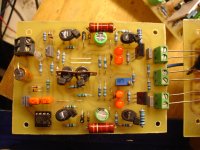 DSC08885.JPG576.9 KB · Views: 821
DSC08885.JPG576.9 KB · Views: 821 -
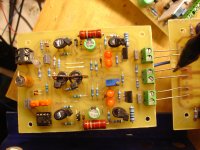 DSC08887.JPG571.3 KB · Views: 748
DSC08887.JPG571.3 KB · Views: 748 -
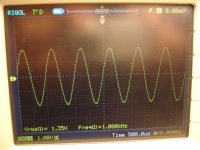 DSC08889.JPG574.7 KB · Views: 700
DSC08889.JPG574.7 KB · Views: 700 -
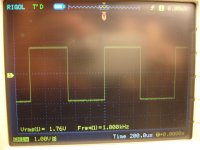 DSC08890.JPG546.5 KB · Views: 652
DSC08890.JPG546.5 KB · Views: 652 -
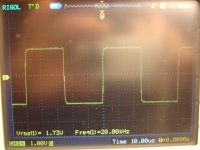 DSC08892.JPG563.9 KB · Views: 649
DSC08892.JPG563.9 KB · Views: 649 -
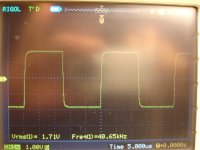 DSC08893.JPG561.8 KB · Views: 209
DSC08893.JPG561.8 KB · Views: 209 -
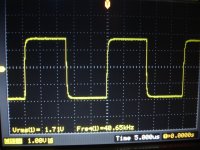 DSC08895.JPG571.8 KB · Views: 209
DSC08895.JPG571.8 KB · Views: 209 -
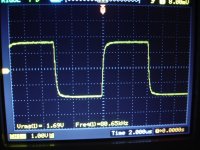 DSC08899.JPG570.3 KB · Views: 210
DSC08899.JPG570.3 KB · Views: 210 -
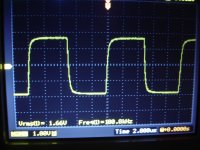 DSC08900.JPG566.6 KB · Views: 224
DSC08900.JPG566.6 KB · Views: 224 -
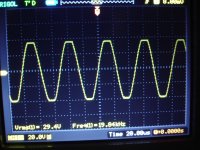 DSC08901.JPG582.4 KB · Views: 251
DSC08901.JPG582.4 KB · Views: 251
Last edited:
Thimios,
That looks real nice on your scope. Is there anything any better on sq waves than that at 20Khz and above?
That looks real nice on your scope. Is there anything any better on sq waves than that at 20Khz and above?
Sorry Kindhornman i don't understand your question because......my bad English.Please ask again with more details.I will come back with more measurements later,if it is any interesting.Thimios,
That looks real nice on your scope. Is there anything any better on sq waves than that at 20Khz and above?
Thimios
Thimios,
What I was trying to say in not so simple English was have any of the other input sections you have built had better sq wave results than this input section? They look very good so high above the audio band. I would have to go back and look at all your previous postings to compare the SW results to see if anything else looks as good as what you are now showing. To me that looks excellent, no ringing or anything else to offend.
What I was trying to say in not so simple English was have any of the other input sections you have built had better sq wave results than this input section? They look very good so high above the audio band. I would have to go back and look at all your previous postings to compare the SW results to see if anything else looks as good as what you are now showing. To me that looks excellent, no ringing or anything else to offend.
Ok understand now,i can't remember all these IPS😱Thimios,
What I was trying to say in not so simple English was have any of the other input sections you have built had better sq wave results than this input section? They look very good so high above the audio band. I would have to go back and look at all your previous postings to compare the SW results to see if anything else looks as good as what you are now showing. To me that looks excellent, no ringing or anything else to offend.
Yes i believe that this IPS is something special but someone must see previous IPS again for sure.Just now i see that forgot to get a speed (μs)measurement
Gentlemen,
May I make a suggestion?
That some, or many make a contribution for testing
the amp and its variations? I'm not talking anything
like permanent donations. But we are going to need
someone a volunteer with enough test gear and experience
or someone with some test gear and a mentor to guide them
through testing all the amp variations in a set of sittings.
That is take what is the best representation of everything
put it all together and run it though a complete set of tests
Then change the amp board and do it again.
For example something like this:
Do the 1 2, 3, slewmaster with a known good amp, for example:
A = #1 plus NAD-S v1.2.
B = #2 plus NAD-S v1.2.
C = #3 plus NAD-S v1.2.
Then we have a base line of one amp with the three different power
units.
Then choose 1, 2, or 3, for the comparison to all the other amps.
About 20 tests in all assuming something doesn't blow up.
If we can get one example of each board, someone to do the testing,
with the right gear, maybe someone to assist after the test to help
pull and remove boards etc etc...
If you really wanted to make a kewl deal of it, meet somewhere in
the middle, say Texas, and everyone agree to come check it out and have a
slewmaster fest and test everything there.
Otherwise have someone with knowledge of this, agree to compile all
the boards etc, test and ready them then send the whole batch to someone
we all trust that would do the measurements.
Crank out all the plots, post the results, etc.
That would be for the test equipment testing.
Then you do the human ear testing. This would be
a group of folks with working amps agree to audition
each different board in their home systems and post
the results. This might occur over several weeks or
months as listener fatigue etc will get you pretty
quickly and everyone will become numb.
It would work something like this:
Boarder="1"]
|
Amp
|
Person
|-
|
4
|
Za
|-
|
5
|
Zb
|-
|
6
|
Zc
|-
|
7
|
Zd
|-
|
8
|
Ze
|-
|
9
|
Zf
|-
|
10
|
Zg
|-
|
11
|
Zh
|-
|
12
|
Zi
|-
|
13
|
Zj
|-
Then on week two, everyone pulls the board and sends it to the next
person on the list. Za sends board 4 to Zb, Zb sends board 5 to Zc...
...Zj sends board 13 to Za. Person on the end of the list sends his
to the person at the beginning of the list.
This testing would take about 13 weeks. You could circulate a questionnaire
or set up one online and everyone would fill it out each week or as they go
through an amp. Only at the end the in room testing would the results be
shown to everyone.
In this way everyone would get the chance to hear each different amp
topologies in their own system. They hear and know the differences.
They can then compare to the testing to see what was measured.
This is the only way to know what the amp topologies sound like with
out building each one yourself and testing it in your own system.
Some work yes, but seems it would also be a lot of fun too.
1-3. SLEWMASTER OPS's (V1.2 -3 of them) the "baby" , "master" and monster"
....3 power levels of EF3 goodness. POST(s) #500 , 502 , 504
4. NAD-S-v1.2 IPS (CFA) - Based on the excellent "NX" with servo DC and the
Hawksford Cascode. Member NAF says "it sings" gracefully. Post #518
Post #518
5. Wolverine-V1.2 IPS (VFA) - "blameless" based with PPM ultra low distortion.
Next logical refinement after the "Badger". POST #599
6. CFA-X and "XH" (CFA , of course) - Similar to the "VSSA/peeceebee" , a very simple amp usable
with the "slew" OPS's. POST #701 -perfected (684 is an error - do NOT use ! )
Edit ... post #2739 is the official schema for the "new" version for CFA-X "H" (hawksford powered).
7. Spookyamp (VFA) Based on the 2500$ Harmon kardon 990 receiver ... uses the classic
Georgia Tech "Leach" topology. Post #803 V1.1 ...
8. Symasui (VFA) - the DIYA "symasym" on steroids post #1628 , almost forgot this one .... Post #1628
9. Kypton-C (CFA) - better CFA-X with servo and super-pair. Post # 4729.
10. Kypton -V (VFA) "classic sansui" 3 stage IPS. Post # 5384.
11. EYESEE (CFA) - IC based amp .....post #4944
12. "Infidel" V2 (VFA) - Fast ... Fast !! with kV slew capability. - #5753
May I make a suggestion?
That some, or many make a contribution for testing
the amp and its variations? I'm not talking anything
like permanent donations. But we are going to need
someone a volunteer with enough test gear and experience
or someone with some test gear and a mentor to guide them
through testing all the amp variations in a set of sittings.
That is take what is the best representation of everything
put it all together and run it though a complete set of tests
Then change the amp board and do it again.
For example something like this:
Do the 1 2, 3, slewmaster with a known good amp, for example:
A = #1 plus NAD-S v1.2.
B = #2 plus NAD-S v1.2.
C = #3 plus NAD-S v1.2.
Then we have a base line of one amp with the three different power
units.
Then choose 1, 2, or 3, for the comparison to all the other amps.
About 20 tests in all assuming something doesn't blow up.
If we can get one example of each board, someone to do the testing,
with the right gear, maybe someone to assist after the test to help
pull and remove boards etc etc...
If you really wanted to make a kewl deal of it, meet somewhere in
the middle, say Texas, and everyone agree to come check it out and have a
slewmaster fest and test everything there.
Otherwise have someone with knowledge of this, agree to compile all
the boards etc, test and ready them then send the whole batch to someone
we all trust that would do the measurements.
Crank out all the plots, post the results, etc.
That would be for the test equipment testing.
Then you do the human ear testing. This would be
a group of folks with working amps agree to audition
each different board in their home systems and post
the results. This might occur over several weeks or
months as listener fatigue etc will get you pretty
quickly and everyone will become numb.
It would work something like this:
|
Amp
|
Person
|-
|
4
|
Za
|-
|
5
|
Zb
|-
|
6
|
Zc
|-
|
7
|
Zd
|-
|
8
|
Ze
|-
|
9
|
Zf
|-
|
10
|
Zg
|-
|
11
|
Zh
|-
|
12
|
Zi
|-
|
13
|
Zj
|-
Then on week two, everyone pulls the board and sends it to the next
person on the list. Za sends board 4 to Zb, Zb sends board 5 to Zc...
...Zj sends board 13 to Za. Person on the end of the list sends his
to the person at the beginning of the list.
This testing would take about 13 weeks. You could circulate a questionnaire
or set up one online and everyone would fill it out each week or as they go
through an amp. Only at the end the in room testing would the results be
shown to everyone.
In this way everyone would get the chance to hear each different amp
topologies in their own system. They hear and know the differences.
They can then compare to the testing to see what was measured.
This is the only way to know what the amp topologies sound like with
out building each one yourself and testing it in your own system.
Some work yes, but seems it would also be a lot of fun too.
1-3. SLEWMASTER OPS's (V1.2 -3 of them) the "baby" , "master" and monster"
....3 power levels of EF3 goodness. POST(s) #500 , 502 , 504
4. NAD-S-v1.2 IPS (CFA) - Based on the excellent "NX" with servo DC and the
Hawksford Cascode. Member NAF says "it sings" gracefully.
5. Wolverine-V1.2 IPS (VFA) - "blameless" based with PPM ultra low distortion.
Next logical refinement after the "Badger". POST #599
6. CFA-X and "XH" (CFA , of course) - Similar to the "VSSA/peeceebee" , a very simple amp usable
with the "slew" OPS's. POST #701 -perfected (684 is an error - do NOT use ! )
Edit ... post #2739 is the official schema for the "new" version for CFA-X "H" (hawksford powered).
7. Spookyamp (VFA) Based on the 2500$ Harmon kardon 990 receiver ... uses the classic
Georgia Tech "Leach" topology. Post #803 V1.1 ...
8. Symasui (VFA) - the DIYA "symasym" on steroids post #1628 , almost forgot this one .... Post #1628
9. Kypton-C (CFA) - better CFA-X with servo and super-pair. Post # 4729.
10. Kypton -V (VFA) "classic sansui" 3 stage IPS. Post # 5384.
11. EYESEE (CFA) - IC based amp .....post #4944
12. "Infidel" V2 (VFA) - Fast ... Fast !! with kV slew capability. - #5753
Last edited:
Don't forget burning in time, very alternating with components are different also,they must be
burning in most 50 to more than 100 hour often for function good,all component have burning in
time.
alec
burning in most 50 to more than 100 hour often for function good,all component have burning in
time.
alec
Add a common core of music to review:
Yes along with the testing, everyone chooses two songs to review
that they care to share with everyone else. Someone can collect
them and put them on the CD so everyone while they audition and
amplifier topology can also audition everyoness music too.
I don't know if anyone has ever done this before, but it sure would
help everyone learn, grow, and understand the differences if any,
in these amp topologies and what they may sound like.
Once you get that accomplished, then you can do another
group go round test for pre amps, CD players, etc.
and the beat goes on....
Yes along with the testing, everyone chooses two songs to review
that they care to share with everyone else. Someone can collect
them and put them on the CD so everyone while they audition and
amplifier topology can also audition everyoness music too.
I don't know if anyone has ever done this before, but it sure would
help everyone learn, grow, and understand the differences if any,
in these amp topologies and what they may sound like.
Once you get that accomplished, then you can do another
group go round test for pre amps, CD players, etc.
and the beat goes on....
No meaning to test för sound DIY ,different component and many factors vill play,
A consumer amplifier have same component and they sound the same,quality in components
are diy can use and trim better sound and power supply components are very inportant.
If amplifier do sit job to drive speaker good, all sound different but are good, is inportant only.
alec
A consumer amplifier have same component and they sound the same,quality in components
are diy can use and trim better sound and power supply components are very inportant.
If amplifier do sit job to drive speaker good, all sound different but are good, is inportant only.
alec
- Home
- Amplifiers
- Solid State
- Slewmaster - CFA vs. VFA "Rumble"